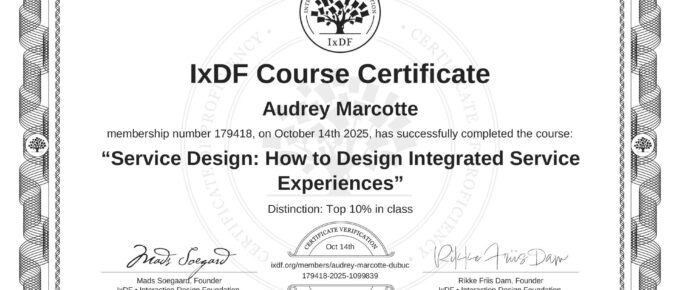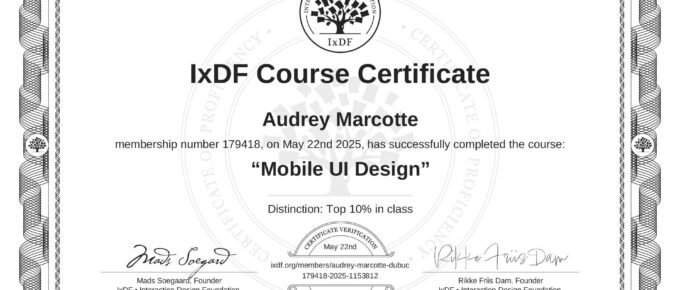“Audrey, I don’t know what to do with this.”
Those were the exact words of a client of mine.
She had just received a report from a consulting firm — but didn’t know what to do with the information.
So, I read the report (which was actually quite good) and, with the help of key internal stakeholders, we built an action plan. That was my first real contact with Service Design.
Together, we developed the service intuitively — collecting insights and best practices along the way.
And I’ve repeated that experience a few more times since. (Service Design projects tend to be long-term journeys!)
Even though there’s nothing quite as revealing as hands-on practice, I still felt the need to take the course Service Design: How to Design Integrated Service Experiences from the Interaction Design Foundation (IxDF).
This training truly helped me deepen and structure my Service Design practice, while enriching my strategic approach.
Here’s a summary of what the course covers — and what resonated most with me (often because it had such strong added value).
Part 1 – Understanding What Service Design Is (and Isn’t)
EHave you ever started a project where the overall vision of the service — what happens before, during, and after the interaction — felt blurry?
That’s exactly where Service Design becomes essential. It connects the dots between teams, processes, and customers to build coherent, human, and efficient experiences.
This first part lays the foundation:
- Service Design isn’t just about improving a website or an app (otherwise, we’d call it Pixel Design!).
- It’s about designing the entire service journey — from the first touchpoint to delivery — including all internal processes.
- It highlights the difference between Service Design and UX Design: one operates on the whole system, the other on the touchpoints.
I particularly appreciated the reflection on the business value of Service Design — learning how to speak the C-suite’s language and demonstrate how integrated experiences reduce friction, increase loyalty, and optimize internal costs. (A true win–win–win!)
Part 2 – Preparing the Service Design Team
“No one is an island.”
A great experience is never the work of a single designer — even though we sometimes wish we could control everything (I’m working on it ;)).
This section focuses on the co-creation and collaboration tools that are key to success:
- Business Model Canvas and Value Proposition Canvas to align business goals and user needs.
- The 5 Whys technique to uncover the root causes of pain points.
- The importance of building a company culture that welcomes experimentation.
I especially loved the part about preparing and facilitating workshops — directly aligned with my own daily practice: designing, yes, but above all helping teams co-create solutions through facilitation.
Part 3 – Building a Solid Research Foundation
LService Design relies on a deep understanding of users and contexts.
This section revisits key methods:
- Qualitative research (interviews, observation, ethnography).
- Role-based personas (a great reminder!).
- Service Safari — observing the service in real life, like a typical user.
The Service Safari exercise can be incredibly insightful — though it seems more applicable to existing services and B2C contexts than to B2B, where simulating a company’s use of a service can be tricky.
This part is a great reminder that field research is a powerful lever to ground design in reality — and sometimes to realize that people don’t use our product at all the way we intended!
Part 4 – Prototyping Services
Here, we move from reflection to action:
- Creating customer lifecycle maps, service blueprints, and ecosystem maps.
- Learning how to make an intangible service tangible.
- The section on Service Staging (rehearsing the service experience before launch) really stood out to me.
Service Staging is about acting out the service scenarios before rollout — like a dress rehearsal. It almost makes me want to bring costumes to my next workshop! (Stay tuned… ;))
Part 5 – Maturing Service Design Within the Organization
The last section focuses on organizational transformation:
- How to integrate Service Design into the company culture (spoiler: it takes more than a post-it workshop!).
- How to measure a service’s performance through both qualitative and quantitative indicators.
- And most importantly, how to engage stakeholders early on — so design doesn’t end up forgotten in a drawer.
It also introduces Lean Service Design principles, which allow teams to experiment faster, with fewer resources, and greater impact. I wish I had known this sooner…
Key Takeaways
As mentioned earlier, this course helped me formalize what I had often been doing intuitively.
It also gave me a shared vocabulary to articulate the value of design at an organizational level.
In the end, Service Design is the art of connecting humans, processes, and technology — to create coherent, useful, and meaningful services.
Conclusion
Without hesitation, I recommend Service Design: How to Design Integrated Service Experiences to all UX, CX, or product professionals who want to step back and act on systems — not just on interfaces.
Plus, this training includes a ton (!) of templates and learning materials. You truly get your money’s worth.
It’s a high-value and inspiring course. As Frank Spillers puts it so well:
“Design is not about pixels — it’s about people, processes, and purpose.”
FAQ
1. Is the IxDF course Service Design: How to Design Integrated Service Experiences suitable for experienced designers?
Yes. It’s a solid course that revisits some fundamentals, but most of the content is intermediate to advanced level.
2. How long does it take to complete the course?
Between 18 and 30 hours, depending on your pace and experience level.
3. In what languages is the content available?
The course materials (videos, texts, tools) are available in English only.
And you?
Have you taken any IxDF courses yourself?
Come chat with me on LinkedIn — I’d love to exchange experiences!



